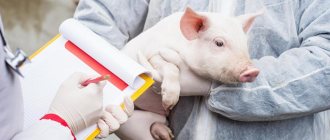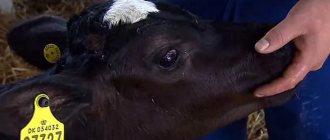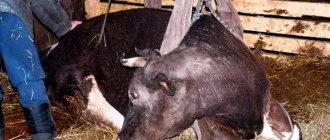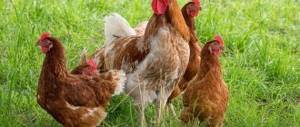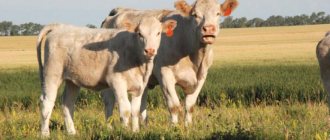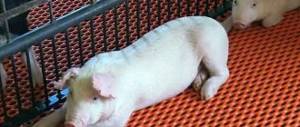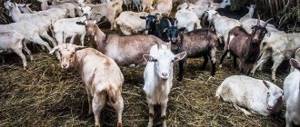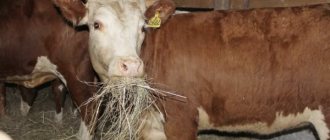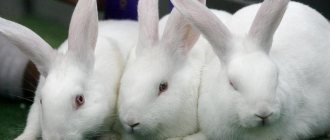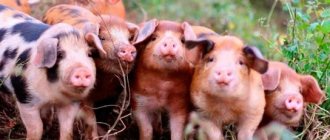Constipation in a piglet may indicate the presence of serious pathologies, the consideration of which is vital for the animal. People who keep small pigs may think that the pigs are absolutely healthy, because their activity and behavior have not changed.
It is important to remember that constipation in piglets is not a specific disease, it is only a symptom
, untimely elimination of which may soon turn into a problem. If the pig is young, then negligence and ignoring the problem can result in death.
How to identify constipation in pigs
Early recognition of the presence of negative painful symptoms in a pet is a very important step towards its treatment. Before you do anything, you need to understand the symptoms of constipation in pigs. Veterinarians have identified the following main indications for the emergence and development of the problem:
- parched skin;
- sharp amplitude changes in temperature (increase to 38-40C);
- lack of appetite even for your favorite food;
- constantly lowered head;
- lethargy and general fatigue;
- bright red rash;
- bent legs and bent body;
- shortness of breath, etc.
The appearance of indications can be caused by improperly selected nutrition, non-compliance with hygiene standards, lack of necessary trace elements and minerals, poor living conditions in the barn (too cold or hot). Inconsistency in meal times each day and improper feeding methods (over-dried or wet food) can also negatively affect the health of the piglet.
Nutrition is the first thing you should pay attention to when constipation occurs in piglets and pigs.
Other symptoms include the fact that the water level in the piglet's drinking bowl remains unchanged throughout the day.
If, when you press on the belly, the pig begins to make terrible sounds and squeaks, it is necessary to examine it for the presence of bloating.
Another common cause of constipation in pigs is insufficient exercise or exercise. It is important to take your pets for walks only to proven places without possible dangerous objects or other farm animals.
Common warning signs
Only a veterinarian’s opinion can confirm or refute the fact of illness. However, experts identify a list of symptoms, the manifestation of which with a high degree of probability means the occurrence of certain problems with the health of the animal. Such signs accompanying pig diseases include:
- general depression;
- low activity;
- loss of appetite;
- discharge from the mouth, nose and/or eyes;
- the appearance of spots or rashes on the skin;
- matte shade and tousled stubble;
- a sharp increase in temperature;
- the occurrence of swelling and neoplasms;
- weight loss;
- violation of the consistency and color of the droppings.
If any of these signs are detected, you should contact your veterinarian as soon as possible. The future of not only the individual, but also the entire livestock, largely depends on how quickly the examination is carried out, the diagnosis is made and the necessary measures are taken. After all, many of the swine diseases are contagious and can infect a large number of animals in a short time. And this is fraught with large-scale financial losses.
Causes
Pigs, and especially small piglets, are especially sensitive to housing conditions and feed quality. When the piglet is still with the sow, its immunity, in most cases, protects it from possible infections and stress in the gastrointestinal tract. However, during weaning, disruptions in the digestive tract can occur, especially if the process is carried out incorrectly. Therefore, you should analyze the feeding regime in the last period of time and find out the possible causes of constipation in piglets:
- Long breaks in feeding followed by abundant feeding;
- Introduction of new nutritional components into the diet;
- Complete change of feed;
- Feeding moldy, old, rancid foods to pigs;
- Switching the diet from cooked to raw food or from liquid to dry;
- Insufficient drinking amount in piglets.
The diet of the animals should be re-examined to understand what was done wrong. Perhaps the feed does not have enough necessary vitamins and microelements, or the diet change was too abrupt.
Constipation in piglets can be caused by cramped cages and lack of exercise. In this case, intestinal motility is disrupted and fecal stagnation occurs. To correct this reason, it is enough to create a walking yard.
A possible cause may be intestinal blockage when an animal swallows a foreign object while walking. At the same time, the piglet’s appetite remains good. In this case, the symptoms are as follows:
- Constant head nodding;
- Copious secretion of saliva;
- Increased excitability;
- Frequent swallowing movements.
Constipation in pigs may also indicate the onset of an infectious disease:
- Gastroenteritis. The disease is not contagious if sanitary and preventive requirements are met. The cause of this is feeding low-quality feed. Symptoms: poor appetite and weight loss;
- Bronchopneumonia. The disease is most susceptible to 3-6 week old piglets, which can sneeze and cough on each other and become infected. The cause is poor living conditions: dampness, cold, drafts. The main signs are high t and cough;
- Helminthiasis. Infection with worms can cause them to multiply and cause intestinal blockage. The source of the disease can be an infected sow, an untreated pigsty, or an infected walking area. Symptoms: lack of appetite, restless behavior, weight loss, teeth grinding, coughing;
- Poisoning. It can occur as a result of feeding low-quality potatoes, red beets that have been steamed or sour after cooking, or an increased amount of table salt. Piglets may have elevated temperatures, lack of appetite and lethargy, and may experience vomiting and convulsions.
Constipation
Causes . Many diseases can cause constipation. For example, infection with any infection is often accompanied by diarrhea, which alternates with constipation. This clinic is especially typical for plague, helminths, salmonellosis, etc. Any infection occurs with an increase in body temperature; this symptom can be confused with poisoning.
Many non-communicable diseases also occur with symptoms of gastrointestinal damage, one of which is constipation. Often, these signs accompany gastritis, enteritis, poisoning, bronchopneumonia, etc. These diseases should be distinguished from infectious diseases, or their treatment should be started. If the pig is recovering, then constipation and other symptoms of gastrointestinal damage go away on their own.
Sometimes, overfeeding or feeding poorly digestible feed can cause constipation in a pig.
Symptoms and treatment . Constipation, which is caused by poor nutrition or overfeeding, occurs with the following symptoms: slight hyperthermia of the body, discharge from the nasal cavity, depression, prolonged absence of bowel movements. Constipation of this nature is not dangerous and can be easily treated by taking laxatives.
If your pig population often suffers from constipation, it is necessary to reconsider their diet. In addition to food, it is necessary to provide animals with fresh water, since stagnant water or dirty drinking bowls can also lead to poisoning and cause constipation or diarrhea.
There are cases when an animal does not seem to be sick, and there are no problems with its diet, but it has been constipated for a long time. In this case, we can talk about intestinal blockage. While walking in open areas, a pig may accidentally swallow any object (from a small pebble to nails and sticks). A large object that is not digested in the stomach can easily get stuck in the intestines or esophagus. Symptomatically, this is manifested by copious secretion of saliva from the mouth, frequent swallowing movements and prolonged constipation. Treatment for blockage consists only of surgery. For successful implementation, it is recommended to call a veterinarian.
Constipation in a piglet: what to do
After determining constipation in a piglet, the veterinarian will tell you what to do and how to treat it. At the same time, the owner himself must know how to take emergency measures and help the pet.
The first step for a pig farmer is to draw up a strategic action plan. It is necessary to review the daily and weekly diets for correct formation. The food may have expired long ago, or it may have been stored in poor conditions, subsequently turning into a mixture that is too dry or too wet. In addition to the problems listed above, others may be identified during the analysis:
- a sharp transition from fatty food to dry food, from boiled to steamed;
- good overeating after long-term refusal to eat;
- possible weaning of piglets and transferring them to independent feeding;
- shortage of drinking water or its terrible quality;
- feeding disturbances;
- introduction of new feed structures into the diet, etc.
The pig may have too little space, which makes it difficult to move around. Situations cannot be excluded when constipation is a consequence of infection with bronchitis or pneumonia.
Piglets should be transitioned from breastfeeding to solid food gradually.
In a small piglet, constipation can occur due to an unsuccessful transition to adult food. What should be done? Like infants, they should be gradually transferred to standard foods, starting with small portions. After weaning from the mother, excluding milk from the piglet’s diet is a big mistake . The right decision would be to continue using the usual product and gradually remove it from the menu. Poisoning may be accompanied by increased dehydration, so it is necessary to reproduce water reserves in proper quantities.
It happens that an animal needs urgent help, but there is no access to a veterinarian. What should be the initial treatment and first reinforcement? You need to pour sunflower oil (1 spoon) into the pig’s mouth. The norm for a sow and an adult pig increases to a whole glass of 250 ml.
To ease the painful sensations of pigs, you can drink jelly in water or prepare a decoction of oatmeal. It is advisable to add a few (3-5) drops of iodine tincture to both to obtain an effective antibacterial agent. You cannot force an animal to drink tinctures, so as not to aggravate the situation.
Even if the farmer does not have a medical education, an additional examination can be easily and quickly carried out. It is necessary to carefully examine the piglet’s fecal masses, remember the period of their last appearance and consistency. Their absence for several days is normal in such pets, but it is advisable to seek help from a specialist.
In newborns
Diarrhea in newly born piglets is rarely diagnosed. However, this happens. The main cause of neonatal diarrhea is considered to be infections transmitted from the mother. A piglet can catch the infection even before it is born in the womb of a sow.
In the case of newborns, diarrhea is an almost 100% indicator of infection. The problem requires an immediate response from the farmer owner. Otherwise, there is a risk of losing the entire litter of newborn piglets. Treatment is prescribed for both the cubs and the mother.
At the suckers
Intestinal upset in suckling piglets is caused by a number of reasons:
- mastitis in the sow, which changes the composition of milk, which negatively affects the digestion of infants;
- the onset of rutting in a nursing female can occur a week to a week and a half after giving birth;
- low milk production of the mother, as a result of which the piglets lack food.
Often the reason that the baby is diarrhea is the sow's poor diet . If, for example, the female receives too much food, milk production increases. Piglets begin to receive excess food, which affects the digestive processes in the young body.
For older people
When matured animals are taken away from their mother, they become independent. Such pets are already released from the barn. There are more reasons for bowel dysfunction, for example:
- stressful situations arising in the external environment;
- increased risk of infection;
- eating food that is not suitable for the pig;
- excess fresh grass, which is often eaten by animals.
Often, diarrhea in pigs (both young and adult) appears due to the habit of eating everything. This is especially fraught for piglets that have recently been weaned from a female, whose body has not yet fully formed, and whose digestive system has not become stronger.
What is flatulence?
Bloating is usually described as a feeling:
- high blood pressure",
- "voltage",
- "bloating"
- or a feeling of “fullness” in the abdominal area.
This is often aggravated by abdominal pain, difficulty defecating, and sometimes difficulty putting on pants , which are usually easy to fasten. In worst cases, you may suffer from nausea, vomiting, heartburn, as well as weight loss due to decreased food intake.
Not only does flatulence make you feel like an inflated balloon ready to launch into orbit, but, unfortunately, it often makes you look that way.
We can blame the gases accumulated in the digestive system for these unpleasant symptoms.
How do they get there? When you breathe, eat, drink or chew, you swallow air, and this is partly the cause.
Bacteria also play a role in the accumulation of gases during digestion, working hard on the digestive processes in the intestines and producing small amounts of gas in the process. The accumulation of gases in the intestines can also cause gastrointestinal diseases such as celiac disease.
The accumulated gas then tries to escape. This is the same as releasing the valve on an inflated balloon - the air tends to go where it can, and often not without unwanted sounds. [1-2]
Constipation in sows: features and treatment
Sows have a more complex body structure than pigs. The most difficult and important moment of their life cycle is childbirth. Constipation can occur after childbirth. The sow's body becomes weaker and more easily accessible to infections and bacteria that can cause gastrointestinal disease. The farmer needs to establish the feeding process and help the animal quickly return to its previous shape.
The animal diet of sows should be rich in foods high in minerals, vitamins and other useful substances.
What diet should be administered if a young sow is constipated? Experts have determined the basic rules for farming in the presence of giving birth to sows:
- For 8-10 hours after the survey, you should not feed the animal healthy oat bran porridge, which has laxative properties.
- A pig will not become constipated if the food intake is gradually increased to normal. If you do this earlier, you can cause mastitis or excessive milk production.
- From the fourth day, the sow should have a large amount of beets and carrots in her diet. It is advisable to add hay and grass flour from the 6th day.
- You can't overdo it with nutritious grains. In this case, it is possible to prevent diarrhea and constipation in pigs. To do this, it is necessary to slowly and gradually introduce these products into the daily diet of animals.
If constipation does appear in a pig, then the pig breeder is recommended to begin treatment with cleansing and then laxative saline or regular warm enemas. It is possible to adjust your diet with the help of processed flax seeds, the mucus of which instantly normalizes intestinal function.
Using the above recommendations, it is not difficult to identify the symptoms of constipation in piglets, pigs and sows.
It is important to start treatment immediately after any suspicion arises. Doctors remind that self-medication is harmful and dangerous, therefore, having identified the signs, it is better to seek help from a special doctor. He will prescribe precise and detailed treatment so that the animals recover as quickly as possible and without harm to health.
What causes the pathology
Intestinal dysfunction in small piglets is often observed when they are transferred from milk diet to an adult diet. This is explained by the intestines being unprepared for new foods, especially if the diet changes abruptly.
Stool retention in pigs can occur due to constant overfeeding and improper diet. A common cause of lack of bowel movements is excess water in the body. Also, fecal stagnation is often observed in piglets with a lack of exercise, which occurs due to the cramped conditions of the shed where they live.
If we talk about more serious causes of constipation in pigs, these include:
- gastroenteritis;
- bronchopneumonia;
- poisoning;
- blockage of the intestinal passage;
- helminthiasis
In the case of constipation in one pig, which appears due to infection, the main cause of illness in other pigs is failure to comply with cleanliness standards. In this case, the disease is transmitted through accumulated beams, dirty bedding, common feed, water, etc.
Infectious constipation in pigs requires professional treatment; in this case, laxatives alone are not enough. If stool retention occurs due to a change in diet or lack of water, then you can correct the situation yourself by resorting to medications.
How to treat constipation in pigs and piglets
Ordinary farm pigs do not require special expensive medications; sometimes they even respond positively to treatment with traditional methods. How and with what to treat constipation in pigs using a home first aid kit? Experts suggest using the following treatments:
- Glauber's salt (sodium sulfate) with water and salt. The purpose of this application is to create a situation of dehydration to encourage the use of water.
- Castor oils.
- Petrolatum.
- Vegetable oil.
- Senna (cassia) leaves, which are used to create tinctures and nutritious porridges.
Constipation in pigs can also affect the piglet's condition. A deficiency of milk, its poor quality and consistency, and the sow’s reluctance to feed her babies can result in weight loss and loss of vital nutrients for the piglet.
Starting from the fourth day of life, cleaned dishes should be placed in the pigsty. Purified, warm, boiled water should be poured into it. After 24 hours, it is necessary to dilute the diet with the sow's milk supply. Charcoal or red clay will be an excellent source of minerals, and hay cut into small pieces will enrich the piglet's nutrition.
Boiled, peeled and grated potatoes can be given to babies from 2 weeks of age. If you adhere to exactly the diet recommended by veterinarians for livestock, constipation will not torment either the piglet or the pigs.
Traditional methods
Non-traditional remedies designed to treat diarrhea in a piglet are suitable in the case of a non-viral nature of the disease:
- Babies just born are given water with potassium permanganate (a weak solution). This will serve to prevent bowel disorders.
- For older babies, rice or flaxseed broth (from seeds or grains) will help.
- It is recommended to give your pet herbal infusions (chamomile, calendula, chicory).
- A decoction of oak bark or nettle will have a positive effect. Dosage for preparation: 25 grams of crushed raw materials per 500 ml of water.
- A remedy available to everyone is water mixed with lemon juice.
Water with potassium permanganate
Lemon water
Camomile tea
Medicines
Medicines to combat diarrhea are usually selected by a veterinarian. The severity and accompanying symptoms are taken into account. Common medications include:
- antibiotic Amoxicillin injections;
- Brovaseptol is a powdered antibacterial drug added to feed;
- Akolan, which helps piglets against diarrhea of infectious origin;
- medicinal powder Biovit-80, recommended for pigs of all ages;
- Brovafom, also belonging to the class of antibiotics.
Amoxicillin
Brovaf
Brovaseptol
Biovit-80
Diarrhea
Causes. Digestive and stomach disorders often occur due to feeding low-quality food. Deficiency of nutrients in feed, incorrect feeding technology (lack or excess of one-time feeding). The environment (conditions of keeping animals in the barn, cleanliness, temperature, stress, etc.) is of great importance in the occurrence of the disease.
Symptoms A pig that suffers from poisoning or some other gastrointestinal pathology can be easily distinguished from a healthy one. She experiences many characteristic symptoms: depression, a constantly lowered head, sloppy and dull stubble, dry skin or rash, lack of appetite, changes in normal body temperature.
Small pigs are very sensitive to poisoning, especially those who are transferred to a dairy diet. If you violate the correct diet or feed piglets with low-quality feed, they will develop gastroenteritis or poisoning. In case of poisoning with toxins from rotten food, the piglet begins to suffer from thirst, due to severe pain, the abdominal wall tightens, the ears and snout turn blue. Severe forms occur with symptoms such as diarrhea, which can lead to depletion of the animal’s young body. After a while, diarrhea changes to constipation, after which the pig defecates foul-smelling feces with gas bubbles or traces of blood.
Treatment. At the first manifestations of diarrhea in small piglets, they are transferred to dairy feeding, since the stomach cannot yet fully absorb carbohydrate-based feed. If the cause of diarrhea lies in gastroenteritis, the piglet's stomach is washed with 0.9% saline. solution, after which they drink clean and warm water for some time.
To prevent food poisoning and dehydration, the pig can be given 15-20 milliliters of saline solution with glucose, twice a day. You can use vitamins A, B, C, D. If diarrhea appears very often, the piglet should be given a decoction of oak bark (about 100 milliliters per pig).
